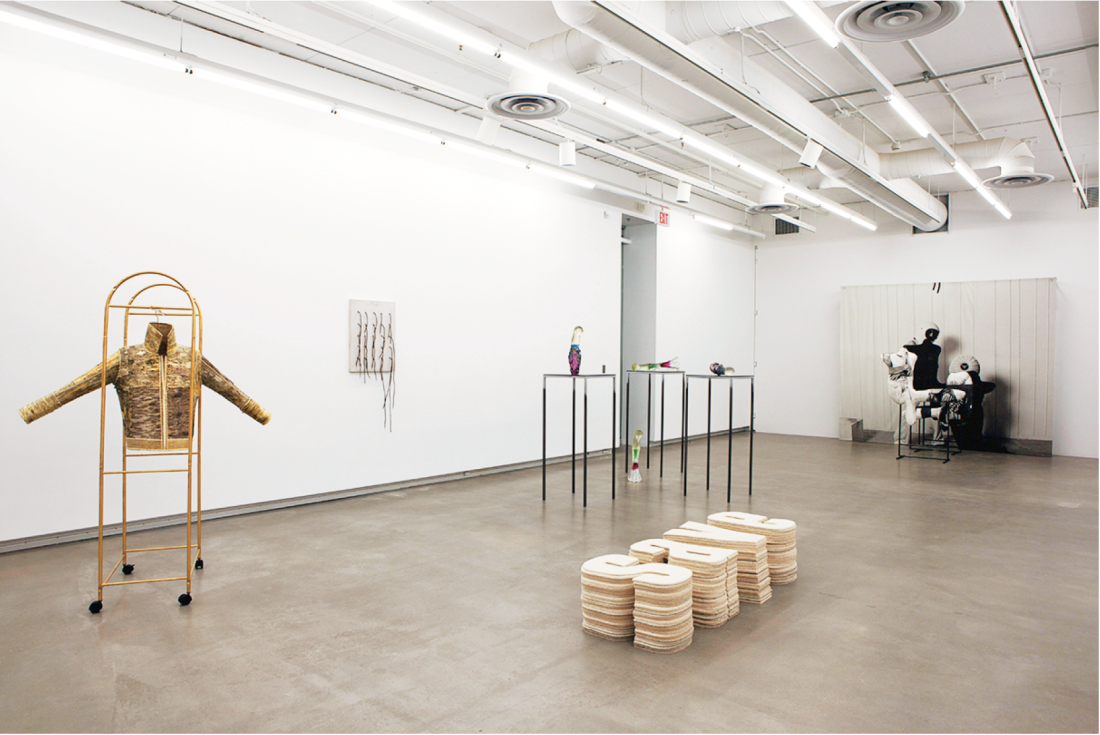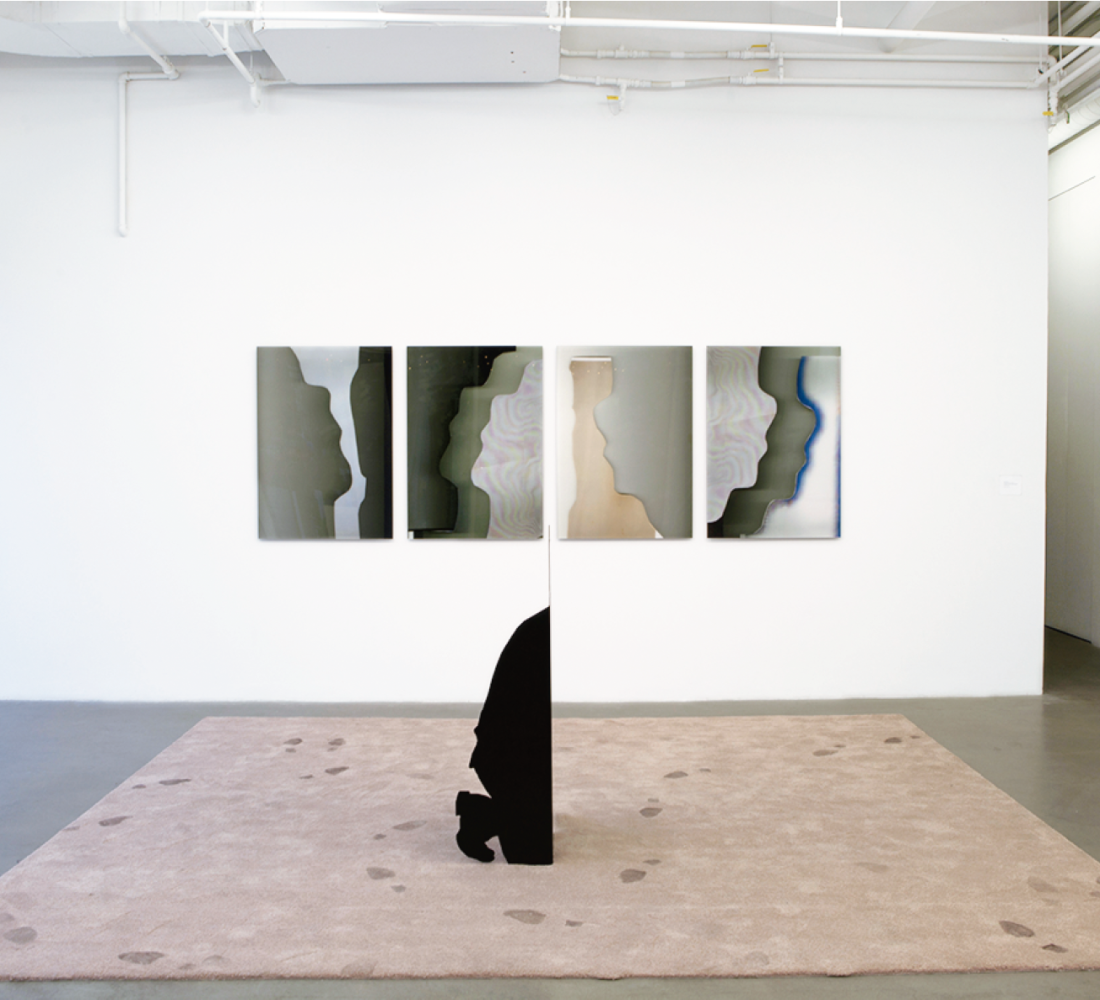“Superimposition: Sculpture and Image”
I like to visit my friends and students in their studios, because that’s where you catch a glimpse of art in its natural habitat. You can see something of what feeds an artistic practice, and observe how work is shaped by the environment in which it comes to be.
My own studio is usually a mess. Eventually, the chaos becomes debilitating and I have to clean up, but most of the time, the mess is good for me. So often, the idea for the next work comes from the sight of one thing lying on top of another: a chance encounter of textures or images that somehow look good together, like maybe they could breed something new. I especially like to catch glimpses of pictures or text through holes I’ve cut out of things. The aesthetic embryos formed by chance are so often fresher and more agile than my more ploddingly deliberate beginnings. They are, to use the terminology of fetal development, more compatible with life.
“Superimposition,” now on at Plug In ICA in Winnipeg, feels a bit like a mannered, cleaner version of my cluttered studio desk. It is a show with a loose premise (“sculpture + image”) even more loosely applied (it’s a struggle to put your finger on where exactly the “image” is in several works), but this imprecise use of terms does have the advantage of encouraging the viewer to make provisional— rather than proscribed—connections between the pieces in the show, and to act like an artist sifting through studio debris, looking for ways to put things together.

Installation view, “Superimposition: Sculpture and Image,” 2016, Plug In ICA, Winnipeg. All images courtesy Plug In ICA.
Emphasis on negative space is a recurring formal element, with several artists contributing work that suggests that what is around the thing might be as fascinating as the thing itself. This is a key principle of observational artmaking, and also a reminder that circumstances and context shape the contours of our interests and even our selves. Kristin Nelson’s A Model for Living: CN Tower, Sydney Opera House, Eiffel Tower, World Trade Centre is a delicious series of creamy ceramic tiles which replicate the leftover bits of foam that remain once a gift-shop model of a famous building has been assembled. The 14 tiles are elegantly arranged on a thin white shelf, grouped by structure. One additional slab has been placed off to the side, discreetly leaning against the wall. The cut-out shapes in this tile are based on the titanium and Oxinium components of Nelson’s surgically replaced knee. This piece travels around the gallery, suggesting a rhyming, moving relationship between Nelson’s body and the spaces of the world.
Nelson’s work is beautifully paired with Kelly Lycan’s SAVE, in which stacked pieces of custom-cut off-white carpet form the letters of the work’s title. This piece, with its one-word plea, is echoed in turn by the odd and compellingly awkward cut-out shape of Dominique Rey’s Untitled #3, a large Plexi structure based on a collage fragment, which suggests both the white flag of surrender and a feathery wing. Much of Rey’s work deals with a disappearing order of nuns; there’s no real way to know this by looking at the pieces in the show, but the whiff of saving grace links Lycan’s work with Rey’s, and also with Andrea Roberts’s three fabric text pieces, which originated in the artist’s interest in the screens that separated extremely cloistered anchorite nuns from the rest of the world.
Subtly but insistently, the show asks the viewer to consider how the way you move through space changes what you can see. Nadia Belerique’s intriguing noir installation involves folded silhouettes that invite you to look not only at but through them; Valérie Blass’s superb, smart and goofy tableau, High-up, dignitary, panjandrum, high muckamuck, has a sweet spot for viewing, in which all the component parts align to make the piece more legible, though no less strange.
As I write this, I am eight months pregnant. Last night I was at an opening, and a friend approached me from the front and then veered to the side, exclaiming, “You’re 3D!” I’ve become a walking optical illusion: my bulging belly is almost invisible if you look at me head-on, but in profile it is protrudingly obvious. The critical formal play in “Superimposition” occurs not so much between image and sculpture, but rather between flatness and three-dimensionality. The thinnest premise can become full and heavy with meaning when viewed from the right angle; what at first appears fragile and flimsy may also be tough, strong and crammed with life. ❚

Nadia Belerique, I Hate You Don’t Leave Me, 2015. Photo: Karen Asher.
“Superimposition: Sculpture and Image” was exhibited at Plug In ICA, Winnipeg, from October 1, 2016 to January 1, 2017.
Erica Mendritzki is an artist and educator living in Winnipeg.

